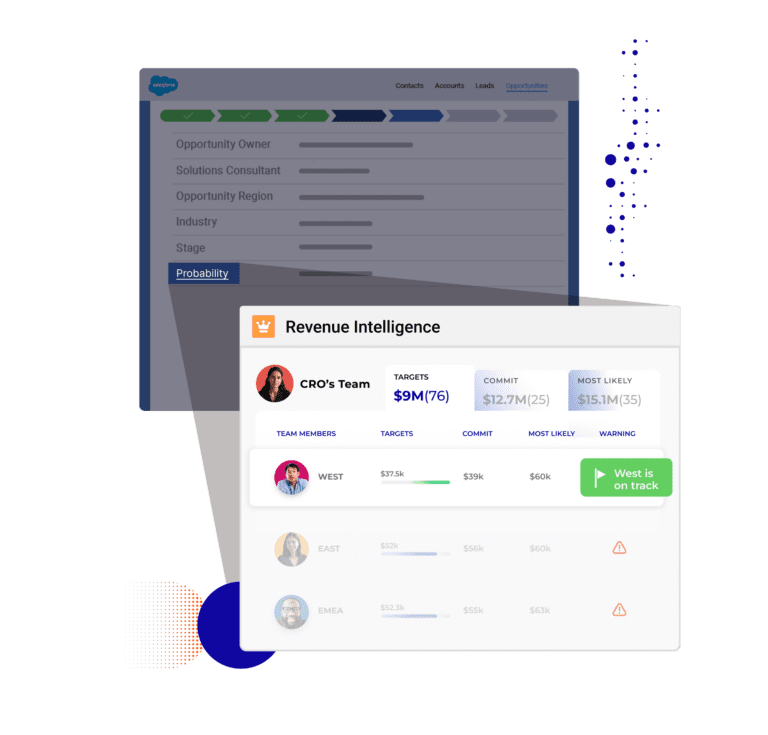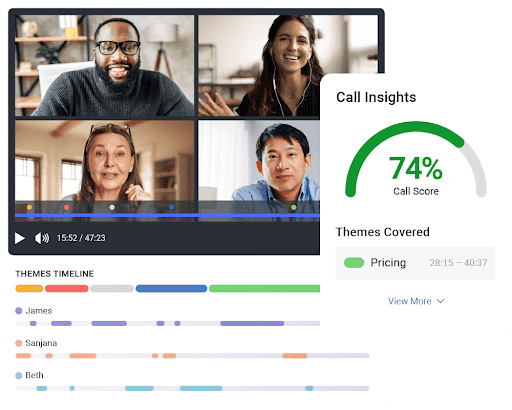Sales forecasting is foundational for any revenue organization. With accurate forecasting, sales teams can make smarter decisions about revenue generation factors, including goal-setting, budgeting, hiring, and prospecting.
But all too often, sales forecasts aren’t accurate. In fact, Gartner found that less than half (45%) of sales leaders have high confidence in their forecast accuracy.
According to Gartner Research
Furthermore, per the Chief Revenue Officer + Sales Leader Outlook Report, over a third (34%) of sales organizations cite inaccurate forecasts and limited predictability in the business as one of their top challenges.
Inaccurate forecasting can negatively impact your entire organization – both in the short- and long-term. As such, revenue teams must have the right forecasting processes and tools in place to ensure more accurate forecasts.
In this post, we’ll look at what sales forecasting involves and why it’s often a struggle for revenue organizations. We’ll also share top tips and best practices to increase the accuracy of your sales forecasts. We’ll cover:
- What is sales forecasting?
- Challenges to accurate forecasting
- How to get started with sales forecasting
- Sales forecasting best practices
- Mistakes to avoid
- Improving forecasting accuracy with AI
What is sales forecasting?
Sales forecasting is the process of predicting revenue for a certain period of time. It drives helps you understand where you’re off base. It also helps you find risks in your pipeline so you can correct them and close more deals.
Effective forecasting requires certain elements such as:
Consistency brings predictability. If your sales process and practices change every quarter, you’ll struggle to get correct data to create an accurate forecast. Consistent processes can even help make up for CRM data hygiene issues (though keeping your data clean is far better!).
If you’re transparent with your numbers and calls throughout your organization, everybody will have a better idea of where your business stands. Transparency works as a great behavior change mechanism for sales reps, as it gives them visibility into your numbers, how you got to them, and the next steps to follow to hit them.
Different segments in your business require different forecasting methods to reflect specific sales motions. If you use a one-size fits all approach to your forecasting, you’ll lose valuable insights and data from specific processes, and your forecasting will be limited.
Using multiple forecasting models brings you further insights and better results while helping you map out your numbers more effectively.
Following the idea of using multiple models to get accurate forecasts, here are some of the most common forecasting methods:
Pipeline forecasting method
This is a highly data-reliant method, which makes it one of the most accurate forecasting tools. It assesses the likelihood that a deal will close after analyzing company information like opportunity value and your rep’s win rate.
It can be quite straightforward if you’re using a program that automatically provides you with correct real-time data relevant to your forecasting, boosting its accuracy and helping you understand where everything is in your business. However, if the data you’re providing isn’t accurate or updated, this method will provide zero value to your organization, as it will only give you inaccurate and incomplete forecasting.
Intuitive forecasting
This method is based on your reps’ opinion of their ability to close a deal in a specific time, excluding objective data. The thinking behind this is that your reps are the ones working directly with your prospects, and, as such, they should be able to give you an accurate assessment of their chances of closing the deal.
However, this method is very risky and inconsistent. It’s an approach you can’t scale or unify, and the calculations you get will be different depending on how each of your sales reps is forecasting. Another downfall is that your reps’ forecasts can be quite optimistic — especially if they feel pressure to hit their quotas — and you may end up with forecast numbers far higher than you’re likely to reach.
Historical forecasting
This method is quick and easy, relying on past data to help you forecast. You look at the revenue generated at a specific time and assume that the revenue you’ll make for that matching period will be equal or greater.
This method doesn’t consider seasonality or changes in your buyers’ demand. In an economy where markets change constantly, this can be a questionable method to base your forecasting on. Still, it’s great to help you understand how your business is doing compared to previous quarters or years.
Opportunity stage forecasting
This method also relies heavily on historical data and it works by analyzing how far your prospects are along your pipeline and calculating the chances of the deal closing. This also helps you estimate the rates of success for the different stages of your pipeline.
Despite this method being quite data-driven, it doesn’t account for specific features of every deal, such as the size of the deal or how long the prospect has been in your pipeline. This means this calculation can bring you the same chances of closing a deal with a lead in your pipeline for two weeks or with one who’s been there for three months. If you don’t get high-quality, updated data, your forecast can be highly inaccurate.
Multivariable analysis forecasting
This is considered one of the most accurate forecasting methods. It analyzes different variables such as rep performance, the average length of a sales cycle, and the probability of closing a deal based on the specific opportunity.
This method is tailored to your organization’s systems and processes but requires detailed, accurate data. Your reps should ensure they’re keeping their data up-to-date, and better still, you should employ an advanced revenue intelligence solution.

Length of sales cycle forecasting
This method looks at how long a lead takes to convert into a paying customer. It encompasses data from different sales cycles, depending on their age and size, so you can group each deal type by average sales cycle duration.
This works well if your prospects are being tracked through your pipeline and your records are accurate. Conversation intelligence tools can help you record and analyze prospect interactions while ensuring your reps aren’t spending too much time inputting data.


Any company changes to systems, processes, or policies will affect sales. For example, if you implement new policies dealing with commissions or discounts, your revenue will likely fluctuate until things settle down. You must account for these details to get a highly accurate forecast.
When employees leave or are fired, revenue decreases until your new hires are ready to start closing deals. This too affects your forecasting.
Markets are always changing and it’s important to keep up to date with market and industry changes to get an accurate forecast. Seasonality also enters the game when it comes to market changes, as some services or products are in high demand at a certain time of the year.
When things are looking bright and the economy is strong, buyers are more likely to increase their budgets and spend more. When the economy isn’t looking its best, the sales cycle takes longer, and buyers are likely to need more reassurance before committing. They may also push harder for lower prices.
Whatever your competitors do affects you and your sales. If they lower their prices, your team will have to find a way to compete. If they go out of business, you may see an influx of new customers. Watch your competitors closely when you’re compiling your forecasting data.
Salespeople tend to be overly optimistic about closing a deal and with only 43% of reps hitting their targets, it’s easy to see how this can negatively impact your forecasting.
If you’re introducing new features, products, or pricing plans, your reps may be able to close more deals or close them faster.
7 steps to get started with sales forecasting
Let’s look at how to get started on the right foot with sales forecasting:
- Lay out a sales process your team can follow. When you have a detailed and consistent system in place, and everybody knows about it, it’s far easier for your reps to hit their quota, improving your forecasting accuracy.
- Set individual and team quotas. Working alongside sales leaders and reps to establish your ideal quotas is very important for your business’s long-term success and it substantially informs your sales forecasting.
- Budget for good software. Customer Relationship Management (CRM) tools can help your reps track opportunities and close deals better by giving them an accurate database. Revenue operations & intelligence software analyzes your team’s activities and deals, making your forecasting more accurate and efficient.
- Pick a sales forecasting method that works for you. Review the different forecasting methods. You need to make sure you pick one that works for the specifics of your business needs, capabilities, and goals.
- Use comprehensive data. When you include data from marketing, product, and finance, you get a better insight into your business situation, which helps you get more accurate forecasting. This can include automatically pulling data from every call and email transcript, as well as calendar invite data, to ensure the right title and number of contacts on an account have accepted invitations recently.
- Review previous sales forecasts. Compare current data with past data helps you notice any trends or discrepancies, which in turn helps you adjust your business plans effectively and get accurate data for your forecasting.
- Inform your sales teams and keep them accountable. Any changes you make to your system need to be communicated to your teams so they can be on the same page as you and understand how the changes affect them. Gather feedback from your team regularly also helps you see what works and what needs to be improved to make sure everybody is working to the best of their ability.
Sales forecasting best practices
Once you’ve looked at the steps above, you might want to consider the best practices within the industry. These are easy to follow, and implementing them from the get-go will save you some headaches in the future. Some of these best practices include making sure you’re prioritizing the processes and deals that need it most, standardizing all your processes, getting access to high-quality data, inspecting your deals regularly, and involving stakeholders from all departments within your team.
Some useful tips to hit the ground running when it comes to forecasting are:
End manual data entry
Revenue intelligence and forecasting tools complete data entry tasks faster and more accurately than your reps, freeing their time to do more beneficial things for your business.
Consolidate your tech stack
If you consolidate all your software into a unified platform, you’ll be saving your reps time by giving them easy access to all the information they need — and you’ll be saving yourself money by getting all the services you need in one place.
Create better buyer experiences
The right software gives you the right information about your prospects at the right time, helping you deliver a truly personalized experience and enhancing the likelihood of getting repeat orders from your customers over and over again. Consider solutions that allow you to see whether sales methodologies like BANT or CHAMP are being followed, whether or not sales reps are creating Digital Sales Rooms personalized to customers to share content, and what’s actually happening in emails and on calls.
Sales forecasting mistakes to avoid
Accurate sales forecasting helps you drive revenue and business growth, but there are some things to avoid if you want to make sure you’re getting the most out of your data, such as:
- Relying on input from sellers. Some forecasting methods rely too heavily on sales reps to give you predictions about current deals, which is entirely subjective and often inaccurate.
- Thinking of your forecast as an isolated process. Forecasting must be executed with an all-encompassing approach that includes all departments and key players in your organization.
- Relying on intuition. Intuition isn’t data-driven and, as such, it doesn’t have a lot of value for your forecasting.
Improve your revenue operations with artificial intelligence
Sales forecasting is much easier and more accurate when you have the right data, and the easiest, quickest way to get that is by using artificial intelligence (AI). But it’s not just about better forecasting — the benefits extend across your sales organization:
Optimized revenue at every level
AI can bring all your revenue data together and turn it into complete visibility into the sales process so you can discover pipeline risks, improve operational efficiency, boost win rates, and drive predictable growth.
Increased sales team productivity
Data-driven AI software helps your sales reps get tailored coaching opportunities from their line managers. It gives your managers insights into every call, email, or meeting, helping them identify deal blockers for their sales team. This improves the productivity and efficiency of your salespeople and empowers them to close more deals faster.
Pipeline visibility and operational efficiency
Another perk of AI forecasting software is that it automatically analyzes your data to tell you where your pipeline is growing or decreasing, helping you take the right next steps. It also reduces the need for manual input, allowing your rev ops team to focus on maximizing your revenue and impact.
Unification of your tech stack
Having everything you need automatically and accurately collected in one platform makes everyone’s job easier. Good AI forecasting software brings everything you need into one single dashboard, helping your team access relevant information without having to log into different platforms. (We found out that 51% of sales leadership professionals indicated they were using 10 or more tools.)
Bottom line: Data-driven AI software is a great tool to get highly accurate forecasting, drive your business’s growth, and keep your teams efficient and motivated.
Mindtickle helps you boost your revenue by offering you full visibility into your business’s health while giving you and your teams all the information you need in one single platform.
Sales Forecasting with Mindtickle
Ready to see how Mindtickle can jumpstart your sales forecasting efforts?
Request a DemoThis post originally published in February 2023 and was updated in February 2024.







